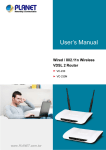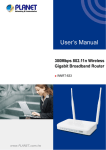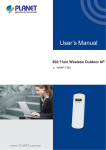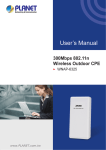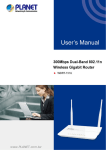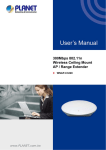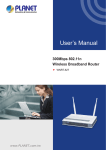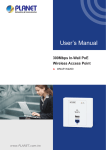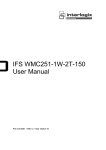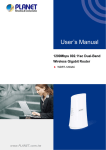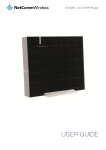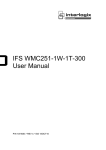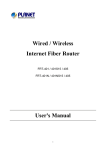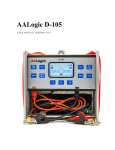Download User Manual of FRT-405N 1 - PLANET Technology Corporation.
Transcript
User Manual of FRT-405N 1 Copyright Copyright 2013 by PLANET Technology Corp. All rights reserved. No part of this publication may be reproduced, transmitted, transcribed, stored in a retrieval system, or translated into any language or computer language, in any form or by any means, electronic, mechanical, magnetic, optical, chemical, manual or otherwise, without the prior written permission of PLANET. PLANET makes no representations or warranties, either expressed or implied, with respect to the contents hereof and specifically disclaims any warranties, merchantability or fitness for any particular purpose. Any software described in this manual is sold or licensed "as is". Should the programs prove defective following their purchase, the buyer (and not this company, its distributor, or its dealer) assumes the entire cost of all necessary servicing, repair, and any incidental or consequential damages resulting from any defect in the software. Further, this company reserves the right to revise this publication and to make changes from time to time in the contents hereof without obligation to notify any person of such revision or changes. All brand and product names mentioned in this manual are trademarks and/or registered trademarks of their respective holders. Federal Communication Commission Interference Statement This equipment has been tested and found to comply with the limits for a Class B digital device, pursuant to Part 15 of FCC Rules. These limits are designed to provide reasonable protection against harmful interference in a residential installation. This equipment generates, uses, and can radiate radio frequency energy and, if not installed and used in accordance with the instructions, may cause harmful interference to radio communications. However, there is no guarantee that interference will not occur in a particular installation. If this equipment does cause harmful interference to radio or television reception, which can be determined by turning the equipment off and on, the user is encouraged to try to correct the interference by one or more of the following measures: 1. Reorient or relocate the receiving antenna. 2. Increase the separation between the equipment and receiver. 3. Plug the equipment into an outlet on a circuit different from that to which the receiver is connected. 4. Consult the dealer or an experienced radio technician for help. FCC Caution: To assure continued compliance, (example-use only shielded interface cables when connecting to computer or peripheral devices) any changes or modifications not expressly approved by the party responsible for compliance could void the user’s authority to operate the equipment. This device complies with Part 15 of the FCC Rules. Operation is subject to the Following two conditions: 2 (1) This device may not cause harmful interference (2) This Device must accept any interference received, including interference that may cause undesired operation. Federal Communication Commission (FCC) Radiation Exposure Statement This equipment complies with FCC radiation exposure set forth for an uncontrolled environment. In order to avoid the possibility of exceeding the FCC radio frequency exposure limits, human proximity to the antenna shall not be less than 20 cm (8 inches) during normal operation. R&TTE Compliance Statement This equipment complies with all the requirements of DIRECTIVE 1999/5/CE OF THE EUROPEAN PARLIAMENT AND THE COUNCIL OF 9 March 1999 on radio equipment and telecommunication terminal Equipment and the mutual recognition of their conformity (R&TTE). The R&TTE Directive repeals and replaces in the directive 98/13/EEC (Telecommunications Terminal Equipment and Satellite Earth Station Equipment) As of April 8, 2000. Safety This equipment is designed with the utmost care for the safety of those who install and use it. However, special attention must be paid to the dangers of electric shock and static electricity when working with electrical equipment. All guidelines of this and of the computer manufacture must therefore be allowed at all times to ensure the safe use of the equipment. National Restrictions This device is intended for home and office use in all EU countries (and other countries following the EU directive 1999/5/EC) without any limitation except for the countries mentioned below: Country Restriction Bulgaria None France Reason/remark General authorization required for outdoor use and public service Outdoor use limited to 10 Military Radiolocation use. Refarming of the 2.4 GHz mW e.i.r.p. within the band band has been ongoing in recent years to allow current 2454-2483.5 MHz relaxed regulation. Full implementation planned 2012 Italy None Luxembourg None Norway Implemented Russian Federation None If used outside of own premises, general authorization is required General authorization required for network and service supply(not for spectrum) This subsection does not apply for the geographical area within a radius of 20 km from the centre of Ny-Ålesund Only for indoor applications 3 User Manual of FRT-405N WEEE regulation To avoid the potential effects on the environment and human health as a result of the presence of hazardous substances in electrical and electronic equipment, end users of electrical and electronic equipment should understand the meaning of the crossed-out wheeled bin symbol. Do not dispose of WEEE as unsorted municipal waste; WEEE should be collected separately. Revision User’s Manual for 802.11n Wireless Internet Fiber Router Model: FRT-405N Rev: 2.0 (August, 2013) Part No. EM-FRT-405N_v2 (2080-B53060-000) 4 User Manual of FRT-405N Table of Contents CHAPTER 1.PRODUCT INTRODUCTION....................................................................................................... 8 1.1 Package Contents .............................................................................................................. 8 1.2 Product Description ........................................................................................................... 9 1.3 Product Features .............................................................................................................. 10 1.4 Product Specifications..................................................................................................... 12 CHAPTER 2. HARDWARE INSTALLATION ................................................................................................. 14 2.1 Hardware Description ...................................................................................................... 14 2.1.1 Front Panel of FRT-405N......................................................................................................... 14 2.1.2 LED Indications of FRT-405N .................................................................................................. 14 2.1.3 Rear Panel of FRT-405N ......................................................................................................... 15 2.2 Cabling .............................................................................................................................. 16 2.2.1 Installing the SFP Transceiver ................................................................................................. 16 2.2.2 Removing the Module .............................................................................................................. 17 CHAPTER 3. CONNECTING TO THE ROUTER ........................................................................................... 19 3.1 System Requirements...................................................................................................... 19 3.2 Installing the Router......................................................................................................... 19 CHAPTER 4. INSTALLATION GUIDE ........................................................................................................... 22 4.1 Configuring the Network Properties............................................................................... 22 4.2 Configuring with Web Browser ....................................................................................... 26 CHAPTER 5. SYSTEM SETTINGS ................................................................................................................ 27 5.1 Operation Mode ................................................................................................................ 29 5.2 Internet Settings ............................................................................................................... 30 5.2.1 WAN ......................................................................................................................................... 30 5.2.2 LAN .......................................................................................................................................... 38 5.2.3 DHCP clients............................................................................................................................ 39 5.2.4 Advanced Routing.................................................................................................................... 39 5.2.5 IPv6 .......................................................................................................................................... 41 5.2.6 ARP Table ................................................................................................................................ 41 5.3 Wireless Setting ............................................................................................................... 42 5.3.1 Basic......................................................................................................................................... 42 5.3.2 Advanced ................................................................................................................................. 45 5.3.3 Security .................................................................................................................................... 48 5 5.3.4 WDS ......................................................................................................................................... 50 5.3.5 WPS ......................................................................................................................................... 52 5.3.6 Station List ............................................................................................................................... 54 5.3.7 Statistics ................................................................................................................................... 54 5.4 Firewall .............................................................................................................................. 55 5.4.1 MAC/IP/Port Filtering ............................................................................................................... 55 5.4.2 Port Forwarding (Virtual Server) .............................................................................................. 57 5.4.3 DMZ.......................................................................................................................................... 59 5.4.4 System Security Settings ......................................................................................................... 60 5.4.5 Content Filtering....................................................................................................................... 61 5.5 Layer 2 functions.............................................................................................................. 63 5.5.1 Port Status ............................................................................................................................... 63 5.5.2 Port Setting .............................................................................................................................. 63 5.5.3 VLAN Setting............................................................................................................................ 64 5.5.4 MAC Address Table ................................................................................................................. 65 5.6 Utilities .............................................................................................................................. 66 5.6.1 Ping Test Setup........................................................................................................................ 66 5.6.2 IPv6 Ping Test.......................................................................................................................... 66 5.6.3 Trace Route ............................................................................................................................. 67 5.6.4 Watch Dog Ping ....................................................................................................................... 68 5.7 Fiber/OAM Setting ............................................................................................................ 69 5.7.1 Fiber Configuration................................................................................................................... 69 5.8 Administration .................................................................................................................. 70 5.8.1 Management ............................................................................................................................ 70 5.8.2 Uploading Firmware ................................................................................................................. 70 5.8.3 Setting Management ................................................................................................................ 71 5.8.4 SNMP Configuration ................................................................................................................ 72 5.8.5 Reboot...................................................................................................................................... 74 5.8.6 Status ....................................................................................................................................... 74 5.8.7 Statistics ................................................................................................................................... 76 5.8.8 System Log .............................................................................................................................. 77 5.8.9 TR-069 Client ........................................................................................................................... 77 5.8.10 NTP ........................................................................................................................................ 78 5.8.11 DDNS ..................................................................................................................................... 79 6 5.8.12 Max Session........................................................................................................................... 83 5.8.13 Session List............................................................................................................................ 83 CHAPTER 6. QUICK CONNECTION TO A WIRELESS NETWORK ............................................................ 84 6.1 Windows XP (Wireless Zero Configuration) .................................................................. 84 6.2 Windows 7 (WLAN AutoConfig) ...................................................................................... 86 6.3 Mac OS X 10.x ................................................................................................................... 89 6.4 iPhone / iPod Touch / iPad .............................................................................................. 93 APPENDIX A: CABLE PROFILES ................................................................................................................. 96 A.1 Device‘s RJ-45 Pin Assignments ................................................................................... 96 A.2 RJ-45 Cable Pin Assignment .......................................................................................... 96 A.3 Fiber Optical Cable Connection Parameter................................................................... 97 A.4 Available Modules............................................................................................................ 98 APPENDIX B: PLANET SMART DISCOVERY UTILITY ............................................................................... 99 APPENDIX C: GLOSSARY .......................................................................................................................... 100 7 User Manual of FRT-405N Chapter 1.Product Introduction 1.1 Package Contents Thank you for choosing PLANET FRT-405N. Before installing the router, please verify the contents inside the package box. FRT-405N Unit Quick Installation Guide CD-ROM (User Manual included) Power Adapter 5dBi Antenna x 2 12V/1A DC output 100~240V AC input If there is any item missing or damaged, please contact the seller immediately. 8 User Manual of FRT-405N 1.2 Product Description Delivering High-Demand Service Connectivity for ISP / Triple Play Devices With built-in 100Base-FX fiber interface, the FRT-405N supports different optic types for WAN and the distance can be up to 15~60 km through the Fiber connection. The FRT-405N is the ideal solution for FTTH (Fiber-to-the-home) applications. It can handle multiple high-throughput services such as IPTV, on-line gaming, VoIP, Internet access and keep the bandwidth usage smoothly. The FRT-405N also incorporates a 4-port 10/100Base-TX switching hub, which makes it easily creates or extends your LAN and prevents the attacks from Internet. High-Speed 802.11n Wireless With built-in IEEE 802.11b/g and 802.11n wireless network capability, the FRT-405N allows any computer and wireless-enabled network device to connect to it without additional cabling. 802.11n wireless capability brings users the highest speed of wireless experience ever; the data transmission rate can be as high as 300Mbps. The radio coverage is also doubled to offer high speed wireless connection even in widely spacious offices or houses. 300Mbps 802.11n 802.11g 802.11b 6X faster 54Mbps 11Mbps *Theory Value Secure Wireless Access Control To secure wireless communication, the FRT-405N supports most up-to-date encryptions including WEP, WPA-PSK and WPA2-PSK. Moreover, the FRT-405N supports WPS configuration with PBC/PIN type for users to easily connect to a secured wireless network. Providing Superior Function The FRT-405N provides user-friendly management interface to be managed easily through standard web browsers. For networking management features, the FRT-405N not only provides basic router functions such as DHCP server, virtual server, DMZ, QoS, and UPnP, but also provides full firewall functions including Network Address Translation (NAT), IP/Port/MAC Filtering and Content Filtering. Furthermore, the FRT-405N serves as an Internet firewall to protect your network from being accessed by unauthorized users. 9 User Manual of FRT-405N 1.3 Product Features Internet Access Features Shared Internet Access: All users on the LAN can access the Internet through the FRT-405N using only one single external IP address. The local (invalid) IP addresses are hidden from external sources. This process is called NAT (Network Address Translation). IEEE 802.3u 100Base-FX standard: The FRT-405N provides long distance connection base on optical fiber transceiver which supports FTTH and IPTV applications. Multiple WAN Connection: Upon the Internet (WAN port) connection, the FRT-405N supports Dynamic IP address (IP address is allocated upon connection), fixed IP address, PPPoE, PPTP and L2TP. Bridge and Router Application: The FRT-405N supports two application modes: bridging and routing modes. Currently, the default mode is routing mode. Note: routing mode and bridging mode cannot be used simultaneously. Advanced Internet Functions Virtual Servers: This feature allows Internet users to access Internet servers on your LAN. The setup is quick and easy. Firewall: The FRT-405N supports simple firewall with NAT technology. Universal Plug and Play (UPnP): UPnP allows automatic discovery and configuration of the Broadband Router. UPnP is supported by Windows ME, XP, or later. User Friendly Interface: The FRT-405N can be managed and controlled through Web UI. DMZ Support: The FRT-405N can translate public IP addresses into private IP address to allow unlimited 2-way communication with the servers or individual users on the Internet. It provides the most flexibility to run programs smoothly for programs that might be restricted in NAT environment. RIP1/2 Routing: It supports RIPv1/2 routing protocol for routing capability. VPN Pass-through Support: PCs with VPN (Virtual Private Networking) software are transparently supported - no configuration is required. LAN Features 4-Port Switch: The FRT-405N incorporates a 4-Port 10/100Base-TX switching hub, making it easy to create or extend your LAN. DHCP Server Support: Dynamic Host Configuration Protocol provides a dynamic IP address to PCs and other devices upon request. The FRT-405N can act as a DHCP Server for devices on your local LAN. Wireless Features Supports IEEE 802.11b, g and 802.11n Wireless Stations: The 802.11n standard provides backward compatibility with the 802.11b and 802.11g standard, so 802.11b, 802.11g, and 802.11n can be used simultaneously. IEEE 802.11n wireless technology is capable of up to 300Mbps data rate. Two External Antennas with MIMO Technology: The FRT-405N provides farther coverage, less dead spaces and higher throughput with 2T2R MIMO technology. 10 User Manual of FRT-405N WPS Push Button Control: The FRT-405N supports WPS (Wi-Fi Protected Setup) for users to easily connect to wireless network without configuring the security. WEP Support: WEP (Wired Equivalent Privacy) is included. Key sizes of 64 bit and 128 bit are supported. WPA-PSK Support: WPA-PSK_TKIP and WAP-PSK_AES encryption are supported. Wireless MAC Access Control: The Wireless Access Control feature can check the MAC address (hardware address) of wireless stations to ensure that only trusted wireless stations can access your LAN. 11 User Manual of FRT-405N 1.4 Product Specifications Model FRT-405N Product Description 300Mbps 802.11n Wireless Internet Fiber Router Hardware Specifications Interface LAN 4 x 10/100Base-TX, Auto-Negotiation, Auto MDI/MDI-X RJ45 port WAN 1 x 100Base-FX SFP slot Wireless 2x 5dBi detachable antenna Connector Optic Interface Mode Distance SFP (Small form-factor Pluggable) Vary on module Vary on module LED Indicators PWR, WAN, LAN1-4, WLAN, WPS, Security Button 1 x RESET button 1 x WPS button Material Plastic Dimensions (W x D x H) 186 x 143 x 35 mm Power 12V DC, 1A Router Features Internet Connection Type Shares data and Internet access for users, supporting the following internet accesses: PPPoE Dynamic IP Static IP PPTP L2TP Max. Session 15000 Fiber-optic cable 50/125μm or 62.5/125μm multi-mode fiber cable, up to 2km. 9/125μm single-mode cable, provide long distance for 15/20/35/50km or longer (very on SFP module) Protocol / Feature Router, Bridge and WISP mode WDS and WPS DMZ and Virtual Server 802.1D QoS DHCP Server / Client IGMP Proxy and DNS Proxy UPnP and DDNS Routing Protocol Static Routing RIPv1/2 VPN VPN Pass-through Security Built-in NAT Firewall MAC / IP/ Port Filtering Content Filtering SPI Firewall support 12 User Manual of FRT-405N System Management Web-based (HTTP) configuration SNTP time synchronize System Log supports Remote Log Password protection for system management Wireless Interface Specifications Wireless Standard IEEE 802.11b, g and 802.11n Frequency Band 2.4 to 2.4835GHz (Industrial Scientific Medical Band ) Modulation Type DBPSK, DQPSK, QPSK, CCK and OFDM (BPSK/QPSK/16-QAM/ 64-QAM) 802.11n(40MHz): 270/243/216/162/108/81/54/27Mbps 135/121.5/108/81/54/40.5/27/13.5Mbps (Dynamic) Data Transmission Rates 802.11n(20MHz): 130/117/104/78/52/39/26/13Mbps 65/58.5/52/39/26/19.5/13/6.5Mbps (Dynamic) 802.11g: 54/48/36/24/18/12/9/6Mbps (Dynamic) 802.11b: 11/5.5/2/1Mbps (Dynamic) Channel Maximum 14 Channels, depending on regulatory authorities Antenna Connector 2 x 5dBi detachable Antenna Wireless Data Encryption 64/128-bit WEP, WPA-PSK, WPA2-PSK, 802.1x encryption, and WPS PBC Standards Conformance Standard Fiber Interface Complaint with IEEE802.3 / 802.3u 10/100 Base-TX, 100Base-FX standard U0 Band Support (25KHz to 276KHz) Packet Transfer Mode Ethernet in the First Mile(PTM-EFM) Environment Specifications Temperature / Humidity Operating: 0~50 degrees C, 5%~ 90% (non-condensing), Storage: -20~70 degrees C, 0~95% (non-condensing) Certification FCC, CE 13 User Manual of FRT-405N Chapter 2. Hardware Installation This chapter offers information about installing your router. If you are not familiar with the hardware or software parameters presented here, please consult your service provider for the values needed. 2.1 Hardware Description 2.1.1 Front Panel of FRT-405N The front panel provides a simple interface monitoring of the router. Figure 2-1 shows the front panel of the FRT-405N. Figure 2-1 FRT-405N Front Panel 2.1.2 LED Indications of FRT-405N The LEDs on the top panel indicate the instant status of system power, WAN data activity and port links, and help monitor and troubleshoot when needed. Figure 2-1 and Table 2-1 show the LED indications of the FRT-405N. 14 User Manual of FRT-405N Front Panel LED Definition LED PWR WPS WLAN Security State ON When the router is powered on, and in ready state. OFF When the router is powered off. ON WPS client registration is successful. Flashing LAN1-4 WPS client registration window is currently open. OFF WPS is not available, or WPS is not enabled or initialized. ON WLAN radio is on. Flashing Data is being transmitted through WLAN. OFF WLAN radio is off. ON Enable WLAN encryption OFF Disable WLAN encryption Flashing WAN Description ON Flashing ON Router is trying to establish a WAN connection to device. The WAN is connected successfully. Data is being transmitted or received via the corresponding LAN port. The port is up. Table 2-1 The LED indication of FRT-405N 2.1.3 Rear Panel of FRT-405N The rear panel provides the physical connectors connected to the power adapter and any other network device. Figure 2-2 shows the rear panel of the FRT-405N. Figure 2-2 FRT-405N Rear Panel 15 User Manual of FRT-405N Rear Panel Port and Button Definition Connector Description POWER Power connector with 12V DC 1 A RESET Press more than 3 seconds for reset to factory default setting. Router is successfully connected to a device through the corresponding port (1, 2, 3, or 4). If the LED light of LNK/ACT is flashing, the Router is actively sending or receiving data over that port. LAN (1-4) WPS WPS on or off switch. WAN The SFP connector allows data communication between the router and the fiber network through a fiber wire 2.2 Cabling 100Base-TX and 100Base-FX The 10/100Mbps RJ-45 ports come with Auto-Negotiation capability. Users only need to plug in working network device into one of the 10/100Mbps RJ-45 ports. The FRT-405N will automatically run in 10Mbps or 100Mbps after the negotiation with the connected device. The FRT-405N has one 100Base-FX SFP interface (Optional Multi-mode / Single-mode 100Base-FX SFP module) Cabling Each 10/100Base-TX ports use RJ-45 sockets - for connection of unshielded twisted-pair cable (UTP). Port Type Cable Type Connector 10Base-T Cat 3, 4, 5, 2-pair RJ-45 100Base-TX Cat.5, 5e, 6 UTP, 2-pair RJ-45 Any Ethernet devices like Hubs / PCs can connect to the Fiber router by using straight-through wires. The 10/100Mbps RJ-45 ports which support Auto MDI / MDI-X can be used on straight-through or crossover cable. 2.2.1 Installing the SFP Transceiver This section describes how to insert a SFP transceiver into an SFP slot. The SFP transceiver is hot-pluggable and hot-swappable. You can plug-in and out the transceiver to/from any SFP port without having to power down the fiber router as the Figure 2-12 appears. 16 User Manual of FRT-405N Figure 2-3 Plug in the SFP transceiver Before connecting the other switches, workstation or Media Converter, 1. Make sure both sides of the SFP transceiver are with the same media type or WDM pair; for example, 100Base-FX to 100Base-FX, 100Base-BX20-U to 100Base-BX20-D. 2. Check whether the fiber-optic cable type matches the SFP transceiver model. To connect to MFB-FX SFP transceiver, use the multi-mode fiber cable, with one side being the male duplex LC connector type. To connect to MFB-F20/F40/F60/FA20/FB20 SFP transceiver, use the single-mode fiber cable, with one side being the male duplex LC connector type. Connecting the fiber cable 1. Attach the duplex LC connector on the network cable to the SFP transceiver. 2. Connect the other end of the cable to a device – switches with SFP installed, fiber NIC on a workstation or a Media Converter. 3. Check the LNK/ACT LED of the SFP slot of the switch / converter. Ensure that the SFP transceiver is operating correctly. 4. Check the Link mode of the SFP port if the link fails. It functions with some fiber-NICs or Media Converters; setting the Link mode to “100 Force” is needed. 2.2.2 Removing the Module 1. Please make sure there is no network activity by console or check with the network administrator. You can access the management interface of the Fiber router to disable the port in advance. 2. Remove the Fiber Optic Cable gently. 3. Turn the handle of the MFB module / mini GBIC SFP module to horizontal. 4. Pull out the module gently through the handle. 17 User Manual of FRT-405N Never pull out the module without pulling the lever or the push bolts on the module. Directly pulling out the module with force could damage the module and SFP module slot of the device. 18 User Manual of FRT-405N Chapter 3. Connecting to the Router 3.1 System Requirements Broadband Internet Access Service (FTTH connection) PCs with a working Ethernet Adapter and an Ethernet cable with RJ-45 connectors PC of subscribers running Windows 98/ME, NT4.0, 2000/XP, Windows Vista / Win 7, MAC OS 9 or later, Linux, UNIX or other platform compatible with TCP/IP protocols The above PC is installed with Web browser 1. The Router in the following instructions is named as PLANET FRT-405N 2. It is recommended to use Internet Explore 7.0 or above to access the Router. 3.2 Installing the Router Please connect the device to your computer as follows: Locate the FRT-405N in an optimum place and adjust the antenna for the best coverage. Figure 3-1 shows the antenna connection diagram. Figure 3-1: FRT-405N Antenna Adjustment Diagram 19 User Manual of FRT-405N Connect your fiber wire to the “WAN” Port via SFP fiber wire.Figure3-2 shows the WAN port connection diagram Figure 3-2: FRT-405N WAN port Connection Diagram Use Ethernet cable to connect “LAN” port of the modem and “LAN” port of your computer. Connect Power Adapter to the FRT-405N. Figure3-3 shows the power adapter connection diagram. Figure 3-3: FRT-405N Power Adapter Connection Diagram 20 User Manual of FRT-405N Follow Figure 3-4 to connect the network devices. Internet Data IPTV Entertainment 100Base-FX Fiber Optical PC (DHCP Client or 192.168.1.2) Figure 3-4: FRT-405N Connection Diagram 21 User Manual of FRT-405N Chapter 4. Installation Guide 4.1 Configuring the Network Properties Configuring PC in Windows 7 1. Go to Start / Control Panel / Network and Internet / Network and Sharing Center. Click Change adapter settings on the left banner. 2. Double-click Local Area Connection. Figure 4-1-1 Select Local Area Connection 3. In the Local Area Connection Status window, click Properties. Figure 4-1-2 Network Connection Properties 22 User Manual of FRT-405N 4. Select Internet Protocol Version 4 (TCP/IPv4) and click Properties. Figure 4-1-3 TCP/IP Setting 5. Select the Obtain an IP address automatically and the Obtain DNS server address automatically button. 6. Click OK to finish the configuration. Figure 0-1-4 Obtain an IP address automatically 23 User Manual of FRT-405N Configuring PC in Windows XP 1. Go to Start / Control Panel (in Classic View). In the Control Panel, double-click on Network Connections 2. Double-click Local Area Connection. Figure 4-1-5 Select Network Connections 3. In the Local Area Connection Status window, click Properties. Figure 4-1-6 24 User Manual of FRT-405N 4. Select Internet Protocol (TCP/IP) and click Properties. Figure 4-1-7 TCP/IP Setting 5. Select the Obtain an IP address automatically and the Obtain DNS server address automatically button. 6. Click OK to finish the configuration. Figure 4-1-8 Obtain an IP address automatically 25 User Manual of FRT-405N 4.2 Configuring with Web Browser It would be better to change the administrator password to safeguard the security of your network. To configure the router, open your browser, type “http: //192.168.1.1” into the address bar and click “Go” to get to the login page. Save this address in your Favorites for future reference. Figure 4-2-1 Login the Router At the User Name and Password prompt, type your proper user name and password to login. The default user name / password are “admin / admin”. You can change these later if you wish. Click “OK”. Figure 4-2-2 Login Window If the user name and password are correct, you will login Fiber Router successfully and see the status page. Now you can configure the Fiber Router for your needs. 26 User Manual of FRT-405N Chapter 5. System Settings Determine your Connection Settings Before you configure the router, you need to know the connection information supplied by your Internet service provider. Connecting the Fiber Router to your Network Unlike a simple hub or switch, the setup of the Fiber Router consists of more than simply plugging everything together. Because the Router acts as a DHCP server, you will have to set some values within the Router, and also configure your networked PCs to accept the IP Addresses the Router chooses to assign them. Generally there are several different operating modes for your applications. And you can know which mode is necessary for your system from ISP. These modes are router, bridge, and PPPoE+NAT. Configuring with Web Browser It is advisable to change the administrator password to safeguard the security of your network. To configure the router, open your browser, type “http: //192.168.1.1” into the address bar and click “Go” to get to the login page. Save this address in your Favorites for future reference. Figure 5-1 Login the Router At the User Name prompt, type “admin”, and the Password prompt, type “admin”. You can change these later if you wish. Click “OK” to login the router and you can start to configure it now. 27 User Manual of FRT-405N Figure 5-2 Login Window 28 User Manual of FRT-405N 5.1 Operation Mode The FRT-405N supports three operation modes – Bridge, Gateway and WISP. Currently, the default setting is Gateway mode. Please note that Bridge mode and Gateway mode cannot be used simultaneously. For Bridge mode, all interfaces are bridged into a single bridge interface. For Gateway mode, the fiber port is treated as WAN port. The other interfaces are bridged together and are treated as LAN ports. For WISP Mode, all the Ethernet ports (including fiber port) are bridged together and the wireless interface of this router will come to WAN port for connecting to an ISP’s Access Point as Internet connection. The NAT is enabled and PCs in Ethernet ports share the same IP to ISP through wireless LAN. The connection type can be set up on WAN page by using PPPoE, DHCP client, PPTP/L2TP client or static IP. If you select Bridge mode and WAN configuration in Internet Settings that are not available, firewall functions on the left page are not available, either. After finishing the settings, click Apply to save the settings and enable the new configuration to take effect. Click Cancel to close without saving. 29 User Manual of FRT-405N 5.2 Internet Settings 5.2.1 WAN The WAN Settings screen allows you to specify the type of Internet connection. The WAN settings offer the following selections for the router’s WAN port, STATIC (fixed IP), DHCP (Auto config), PPPoE, L2TP, and PPTP. STATIC (FIXED IP) Select STATIC (fixed IP) in the WAN Connection Type drop-down list and the following page appears: 30 User Manual of FRT-405N The page includes the following fields: Object IP Address Subnet Mask Default Gateway Primary/Secondary DNS MAC Clone Description Enter the IP address in dotted-decimal notation provided by your ISP. Enter the subnet Mask in dotted-decimal notation provided by your ISP, usually is 255.255.255.0 Enter the gateway IP address in dotted-decimal notation provided by your ISP. Enter one or two DNS addresses in dotted-decimal notation provided by your ISP. Enable or disable MAC clone. DHCP (AUTO CONFIG) Select DHCP (Auto config) in the WAN Connection Type drop-down list and the following page appears. If the WAN connection type is set to DHCP, the device automatically obtains the IP address, gateway and DNS address from the DHCP server on WAN interface. 31 User Manual of FRT-405N The page includes the following fields: Object Description Host Name This option specifies the Host Name of the Router. MAC Clone Enable or disable MAC clone. 32 User Manual of FRT-405N PPPOE Select PPPoE (ADSL) in the WAN Connection Type drop-down list and the following page appears. If the WAN connection type is set to PPPoE, you can configure the following parameters to PPPoE dial up. The page includes the following fields: Object User Name/Password Description Enter the User Name and Password provided by your ISP. These fields are case-sensitive. Fill in the password again for verification. Verify Password Keep Alive: Keep the PPPoE connection all the time. Please also configure the Redial Period field. Operation Mode On Demand: Please configure the Idle Time field. When time is up, the PPPoE connection will disconnect. The connection will re-connect when any outgoing packet arise. MAC Clone Manual: Close all function. Enable or disable MAC clone. 33 User Manual of FRT-405N L2TP Select L2TP in the WAN Connection Type drop-down list and the following page appears. There are two address modes: Static and Dynamic. 1. If you select Static in the Address Mode field, the page shown in the following figure appears: 2. If you select Dynamic in the Address Mode field, the page shown in the following figure appears: 34 User Manual of FRT-405N The page includes the following fields: Object Server IP User Name/Password MTU Description Allow user to make a tunnel with remote site directly to secure the data transmission among the connection. User can use embedded L2TP client supported by this router to make a VPN connection. If you select the L2TP support on WAN interface, fill in the IP address for it. Enter the User Name and Password provided by your ISP. These fields are case-sensitive. The Maximum Transmission Unit default setting is 1500. Address Mode Static: To configure the IP address information by manually, please fill in the related setting at below. Dynamic: The option allows the machine to get IP address information automatically from DHCP server on WAN side. IP Address Fill in the IP address for WAN interface. Subnet Mask Fill in the subnet mask for WAN interface. Default Gateway Fill in the default gateway for WAN interface out going data packets. Keep Alive: Keep the L2TP connection all the time. Please also configure the Redial Period field. Manual: All functions are disabling. Enable or disable MAC clone. Operation Mode MAC Clone 35 User Manual of FRT-405N PPTP Select PPTP in the WAN Connection Type drop-down list and the following page appears. There are two address modes: Static and Dynamic. The page includes the following fields: Object Description Allow user to make a tunnel with remote site directly to secure the data transmission among the connection. User can use embedded PPTP Server IP client supported by this router to make a VPN connection. If you select the PPTP support on WAN interface, fill in the IP address for it. User Name/Password MTU Enter the User Name and Password provided by your ISP. These fields are case-sensitive. The Maximum Transmission Unit default setting is 1500. Static: To configure the IP address information by manually, please fill Address Mode in the related setting at below. Dynamic: The option allows the machine to get IP address information automatically from DHCP server on WAN side. IP Address Fill in the IP address for WAN interface. 36 User Manual of FRT-405N Subnet Mask Fill in the subnet mask for WAN interface. Default Gateway Fill in the default gateway for WAN interface out going data packets. Keep Alive: Keep the PPTP connection all the time. Please also Operation Mode configure the Redial Period field. Manual: No function is enabling. MAC Clone Enable or disable MAC clone. 37 User Manual of FRT-405N 5.2.2 LAN This page allows you to enable or disable networking functions and configure their parameters according to your practice. The page includes the following fields: Object MAC Address IP Address Subnet Mask MAC Address DHCP Type Start IP Address Description The physical address of the Router, as seen from the LAN. The value can't be changed. Enter the IP address of your Router or reset it in dotted-decimal notation (factory default: 192.168.1.1). An address code that determines the size of the network. Normally use 255.255.255.0 as the subnet mask. MAC address of LAN port (Read-only). Disable: Disable DHCP server on LAN side. Server: Enable DHCP server on LAN side. Fill in the start IP address to allocate a range of IP addresses; client 38 User Manual of FRT-405N with DHCP function set will be assigned an IP address from the range. End IP Address Fill in the end IP address to allocate a range of IP addresses; client with DHCP function set will be assigned an IP address from the range. Subnet Mask The subnet mask of dynamic IP. Primary DNS Server The primary DNS server address. Secondary DNS Server The secondary DNS server address. Default Gateway Fill in the default gateway for LAN interfaces out going data packets. Lease Time Fill in the lease time of DHCP server function. Statically Assigned 802.1d Spanning Tree LLTD Assign IP to the assigned MAC address. Enter the assigned MAC address and IP in the corresponding fields. Select enable or disable the IEEE 802.1d Spanning Tree function from pull-down menu. Select enable or disable the Link Layer Topology Discover function from pull-down menu. IGMP Proxy Select enable or disable the IGMP proxy function from pull-down menu. UPNP Select enable or disable the UPnP protocol from pull-down menu. Router Advertisement You can select Enable or Disable. PPPoE Relay You can select Enable or Disable. DNS Proxy Select enable or disable the DNS Proxy function from pull-down menu. 5.2.3 DHCP clients You can view the information about DHCP clients on the page. 5.2.4 Advanced Routing You can add or delete routing rules, and enable or disable dynamic routing protocol on the page. 39 User Manual of FRT-405N The page includes the following fields: Object Description Destination Enter the legal destination IP address. Range Destination IP address is a host address or the network address. Gateway Enter the specific gateway. Interface The interface for this route. You can select LAN, WAN and Custom. Comment Add the description of this route. Current Routing Table in the System You can delete or reset the routing rules. Dynamic Routing Settings You can enable or disable the RIP. After finishing the settings above, click Apply to enable the new routing rule to take effect. Otherwise, click Reset to cancel the new routing rule. 40 User Manual of FRT-405N 5.2.5 IPv6 You may set up rules to provide Quality of Service (QoS) guarantee for some specific applications. On the page, you can enable or disable Quality of Service. The page includes the following fields: Object Description Address You can set up IPV6 address here. Prefix You can set up the IPv6 Prefix here. Router You can set up the IPv6 router here. 5.2.6 ARP Table You can view the information about ARP Table on the page. 41 User Manual of FRT-405N 5.3 Wireless Setting 5.3.1 Basic You can configure the minimum number of wireless settings for communication, such as network name (SSID) and channel. The page includes the following fields: Object Description Driver Version Show the driver version. WiFi On/Off Enable or disable the wireless LAN. Network Mode This field determines the wireless mode which the Router works on. Network Name (SSID) Enter a value of up to 32 characters. The same name of SSID (Service Set Identification) must be assigned to all wireless devices in your network. Considering your wireless network security, the default SSID is set to be default. This value is case-sensitive. For example, PLANET 42 User Manual of FRT-405N is NOT the same as planet. Multiple SSID 1/2/3/4 There are 4 multiple SSIDs. Enter their descriptive names that you want to use. Broadcast Network Select Enable to allow the SSID broadcast on the network, so that the Name (SSID) STA can find it. Otherwise, the STA cannot find it. AP Isolation Enable or disable AP Isolation. When many clients connect to the same access point, they can access each other. If you want to disable the access between clients which connect the same access point, you can enable this function. MBSSID AP Isolation Enable or disable MBSSID AP Isolation. BSSID Basic Service Set Identifier. This is the assigned MAC address of the station in the access point. This unique identifier is in Hex format and can only be edited when Multi BSSID is enabled in the previous screen. A channel is the radio frequency used by wireless device. Channels Frequency (Channel) available depend on your geographical area. You may have a choice of channels (for your region) and you should use a different channel from an adjacent AP to reduce the interference. The Interference and degrading performance occurs when radio signals from different APs overlap. HT Physical Mode 43 User Manual of FRT-405N The page includes the following fields: Object Description Operation Mode Select Mixed Mode or Green Field. Channel Bandwidth Select 20 or 20/40. Guard Interval Select 20 or 20/40. MCS Select the proper value from 0 to 32. Auto is the default value. The purpose of the 802.11n RD protocol is to more efficiently transfer Reverse Direction Grant (RDG) data between two 802.11 devices during a TXOP by eliminating the need for either device to initiate a new data transfer. Select Disable or Enable. Space time block coding is a technique used in wireless communications to transmit multiple copies of a data stream across a Space Time Block Coding (STBC) number of antennas and to exploit the various received versions of the data to improve the reliability of data-transfer. Select Disable or Enable. A-MSDU aggregation, which allows several MAC-level service data Aggregation MSDU (A-MSDU) units (MSDUs) to be aggregated into a single MPDU. Select Disable or Enable. Auto Block ACK Decline BA Request HT Disallow TKIP Not to respond to each sent data (ACK), but to block unit (Block). Select Disable or Enable. To decline the Block ACK request by the other devices. Select Disable or Enable. Using TKIP, the operation will be in 802.11g. Select Disable or Enable. HT TxStream Select 1 or 2. HT RxStream Select 1 or 2. 44 User Manual of FRT-405N 5.3.2 Advanced This page includes more detailed settings for the AP. Advanced Wireless Settings page includes items that are not available on the Basic Wireless Settings page, such as basic data rates, beacon interval, and data beacon rate. The page includes the following fields: Object BG Protection Mode Description It provides 3 options, including Auto, On, and Off. The default BG protection mode is Auto. Beacon Interval The interval time range is between 20ms and 999ms for each beacon transmission. The default value is 100ms. Date Beacon Rate (DTM) The DTM range is between 1 ms and 255 ms. The default value is 1ms. This is the maximum data fragment size (between 256 bytes and 2346 Fragment Threshold bytes) that can be sent in the wireless network before the router fragments the packet into smaller data frames. The default value is 2346. Request to send (RTS) is designed to prevent collisions due to hidden RTS Threshold node. A RTS defines the biggest size data frame you can send before a RTS handshake invoked. The RTS threshold value is between 1 and 45 User Manual of FRT-405N 2347. The default value is 2347. Tx Power The Tx Power range is between 1 and 100. The default value is 100. Short preambles work with every wireless type other than older types Short Preamble with limited transmission rates in the 1 to 2 Mbps range. Select Disable or Enable. Short slot time reduces the slot time from 20 microseconds to 9 Short Slot microseconds, thereby increasing throughput. Select Disable or Enable. TX burst is a feature for wireless device speed up the connection in the Tx Burst same environment as it is without. Select Disable or Enable. Pkt_Aggregate Country Code Select Disable or Enable. Select the region which area you are. It provides three regions in the drop-down list. Object Description WiFi Multimedia (WMM) refers to Qos over WiFi. It is suitable for simple WMM Capable applications that require QoS, such as Voice over IP (VoIP) Enable or disable WMM. Automatic power save delivery (APSD) is an efficient power APSD Capable management method. Enable or disable APSD. Direct-Link Setup (DLS) are able to automatically create a secure, DLS Capable direct link between them after accessing the Wi-Fi network, removing the need to transmit data through the access point. Enable or disable DLS. 46 User Manual of FRT-405N Object Description There are two main ways that Windows Media servers send data to Multicast-to-Unicast Windows Media Player clients: multicast and unicast. Enable or Disable Multicast-to-Unicast 47 User Manual of FRT-405N 5.3.3 Security Choose Wireless Settings>Security and the following page appears. It allows you to modify the settings to prevent the unauthorized accesses. The page includes the following fields: Object SSID choice Security Mode Description Select SSID in the drop-down list. There are 5 options, including Disable, OPENWEP, WPA-PSK, WPA2-PSK, and WPAPSKWPA2PSK. [EXAMPLE] Take WPAPSKWPA2PSK for example. Select WPAPSKWPA2PSK in the Security Mode down-list. The page shown in the following page appears: 48 User Manual of FRT-405N Access Policy Object Description There are three options, including Disable, Allow, and Reject. Select Policy Allow, only the clients whose MAC address is listed can access the router. Select Reject, the clients whose MAC address is listed are denied to access the router. If you want to add a station MAC, enter the MAC address of the Add a station MAC wireless station that are allowed or denied access to your router in this address field. 49 User Manual of FRT-405N 5.3.4 WDS WDS (Wireless Distribution System) allows access points to communicate with one another wirelessly in a standardized way. It can also simplify the network infrastructure by reducing the amount of cabling required. Basically the access points will act as a client and an access point at the same time. WDS is incompatible with WPA. Both features cannot be used at the same time. A WDS link is bi-directional, so the AP must know the MAC address of the other AP, and the other AP must have a WDS link back to the AP. Dynamically assigned and rotated encryption key are not supported in a WDS connection. This means that WPA and other dynamic key assignment technologies may not be used. Only Static WEP keys may be used in a WDS connection, including any STAs that are associated with a WDS repeating AP. Enter the MAC address of the other APs that you want to link to and click enable. Supports up to 4 point to multipoint WDS links, check Enable WDS and then enable on the MAC addresses. WDS Mode: There are four options, including Disable, Lazy Mode, Bridge Mode, and Repeater Mode. Disable Select Disable to disable the WDS mode. Lazy Mode 50 User Manual of FRT-405N The page includes the following fields: Object Lazy Mode Phy Mode Encryp Type Description The FRT-405N WDS Lazy mode is allowed the other FRT-405N WDS bridge / repeater mode link automatically. It provides 4 options, including CCK, OFDM, HTMIX, and GREENFIELD. It provides 4 options, including None, WEP, TKIP, and AES. Bridge Mode/ Repeater Mode Object WDS Mode Phy Mode Encryp Type AP MAC Address Description Select Bridge Mode or Repeater Mode. It provides 4 options, including CCK, OFDM, HTMIX, and GREENFIELD. It provides 4 options, including None, WEP, TKIP, and AES. It provides 4 AP MAC Address. Enter the MAC address of the other APs. 51 User Manual of FRT-405N 5.3.5 WPS You can enable or disable the WPS function on this page. Select Enable in the WPS drop-down list. Click Apply and the following page appear. 52 User Manual of FRT-405N WPS Summary It displays the WPS information, such as WPS Current Status, WPS Configured, and WPS SSID. Object Reset OOB Description Reset to out of box (OoB) configuration WPS Progress There are two ways for you to enable WPS function: PIN or PBC. You can use a push button configuration (PBC) on the Wi-Fi router. If there is no button, enter 4 digit PIN code. Each STA supporting WPS comes with a hard-coded PIN code. Object PIN Description If you select PIN mode, you need to enter the PIN number in the field. WPS Status It displays the information about WPS status. 53 User Manual of FRT-405N 5.3.6 Station List Through this page, you can easily identify the connected wireless stations. It automatically observes the ID of connected wireless station (if specified), MAC address, and current status. 5.3.7 Statistics This page will show you the connected TX, RX statistics. 54 User Manual of FRT-405N 5.4 Firewall The VDSL Router provides the fully firewall functions, such as MAC/IP/Port Filtering, Port Forwarding, DMZ, SPI Firewall and Content Filtering. It serves as an Internet firewall to protect your network from being accessed by outside users. 5.4.1 MAC/IP/Port Filtering Use the MAC/IP/Port filters to deny / allow particular LAN IP addresses from accessing the Internet. You can deny / allow specific port numbers or all ports for a specific IP address. You may set up firewall rules to protect your network from malicious activity on the Internet. It is also convenient for you to delete these settings. 55 User Manual of FRT-405N Basic Settings Object MAC/IP/Port Filtering Default Policy Description Enable or disable the MAC/IP/Port filtering function. The Packet that does not match any rules would be dropped or accepted. MAC/IP/Port Filter Settings Object Source MAC address Dest IP Address Source IP Address Protocol Destination Port Range Source Port Range Description Enter the MAC address that matches the source address of the packet (optional). Enter the IP address that matches the destination address of the packet (optional). Enter the IP address that matches the source address of the packet (optional). There are 4 options, including none, TCP, UDP and ICMP. After setting a valid protocol, you may enter the UPD or TCP destination port range. After setting a valid protocol, you may enter the UPD or TCP source port range. Action Select Drop or Accept in the drop down list. Comment Add description for this rule. The maximum rule number you can add is 32. Current MAC/IP/Port Filtering Rules in System If you want to delete some rules in the table above, select the rules, and then click Delete Selected. Otherwise, click Reset. 56 User Manual of FRT-405N 5.4.2 Port Forwarding (Virtual Server) This page allows you to configure to re-direct a particular range of service port numbers from the Internet network to a particular LAN IP address, and set virtual server to provide services on the Internet. Port Forwarding Settings Object Description Virtual Server Settings Enable or disable this function. After selecting Enable, you can set the following parameters. IP Address Enter the virtual server IP address in internal network. Port Range: You can setup your port range for your WAN side. Protocol There are 3 options, including none, TCP&UDP, TCP and UDP. Comment Add description for this rule. The maximum rule number you can add is 32. 57 User Manual of FRT-405N Virtual Server Settings Object Description Virtual Server Settings Enable or disable this function. After selecting Enable, you can set the following parameters. IP Address Enter the virtual server IP address in internal network. Public Port Enter the WAN service port. Private Port Enter the LAN service port. Protocol There are 3 options, including none, TCP&UDP, TCP and UDP. Comment Add description for this rule. The maximum rule number you can add is 32. 58 User Manual of FRT-405N 5.4.3 DMZ DMZ (De-militarized Zone) allows a single computer on your LAN to expose ALL of its ports to the Internet. Enter the IP address of that computer as a DMZ (De-militarized Zone) host with unrestricted Internet access. When doing this, the DMZ host is no longer behind the firewall. This page allows you to set a De-militarized Zone (DMZ) to separate internal network and Internet. DMZ Settings: Enable or disable this function. After selecting Enable, you can set the DMZ IP address. DMZ IP Address: Enter the DMZ host IP address. 59 User Manual of FRT-405N 5.4.4 System Security Settings Choose Firewall > System Security and the following page appears. This page allows you to configure the system firewall to protect Router from attacking. Remote Management Object Remote management (via WAN) Remote Web management Port Description Deny or allow remote management through web. The default remote management port is 80. You can change the remote management port for your needs. e.g. 8080. Ping from WAN Filter Object Ping from WAN Filter Description You may select enable or disable to determine whether to filter the ping package which comes from the external network. 60 User Manual of FRT-405N Block Port Scan Object Block Port Scan Description You may select enable or disable to determine whether to block the scanning which comes from the external network. Block SYN Flood Object Block SYN Flood Description You may select enable or disable to determine whether to block the SYN Flood attacks come from the external network. Stateful Packet Inspection (SPI) Object SPI Firewall Description You may disable or enable the SPI firewall. 5.4.5 Content Filtering This page is used to configure the Blocked FQDN (Such as tw.yahoo.com) and filtered keyword. Here you can add / delete FQDN and filtered keyword. Choose Firewall > Content Filtering and the following page appears. You can set content filter to restrict the improper content access. 61 User Manual of FRT-405N Webs Content Filters Object Webs Content Filters Description If you want to block some applications as Proxy, Java and ActiveX of web pages please select the check box and click “Apply”. Current Webs URL Filters Object Current Webs URL Filters Description If you want to delete some filters in the table above, select the rules, and then click Delete. Otherwise, click Reset. Add a URL filter Object Description Enter the FQDN and click “Add” to apply this URL filter rule. Add a URL filter Click Add to add a URL filter. Otherwise, click Reset to cancel the URL filter. 62 User Manual of FRT-405N 5.5 Layer 2 functions A single layer-2 network may be partitioned to create multiple distinct broadcast domains. Such a domain is referred to as a Virtual LAN or VLAN. Network administrators set up VLANs to provide the segmentation services traditionally provided by routers in LAN configuration. This page allows you to set the VLAN. 5.5.1 Port Status Choose Layer 2 Function > Port Status and the following page appears. This page displays each port’s Speed, Duplex mode, Flow Control status. 5.5.2 Port Setting This page allows you to select a different Mode, Flow Control or Port Enable. 63 User Manual of FRT-405N The page includes the following fields: Object Port Description This is the LAN port number for this row. You can choose 5 modes. Mode Auto Negotiation 100 Full 100 Half 10 Full 10 Half Please select the check box and click “Apply”. Flow Control You can choose Enable or Disable. Port Enable You can choose Enable or Disable. 5.5.3 VLAN Setting You can enable or disable the VLAN setting. There are four groups that can be set. The first one is NAT group and the others are bridged with WAN port. 64 User Manual of FRT-405N VLAN Mode Setting Mode: You can enable or disable the VLAN here. VLAN Member Configuration Object Description VLAN Group: You can select enable or disable. VID: Set the VID here for each Virtual LAN. LAN1~4: It means the LAN port on the router. PVID: You can set the PVID for each port here. Click Apply to enable the configuration to take effect. Click Cancel to cancel the new configuration. 5.5.4 MAC Address Table This page shows MAC Address Table. Click Refresh button to renew the list above immediately. 65 User Manual of FRT-405N 5.6 Utilities The FRT-405N provides four functions for users to use. 5.6.1 Ping Test Setup This page is used to configure the parameters for Ping Test which pings to IP address or Domain Name. 5.6.2 IPv6 Ping Test This page is used to configure the parameters for IPv6 Ping Test which pings to IPv6 address or Domain Name. 66 User Manual of FRT-405N 5.6.3 Trace Route This page is used to configure the Traceroute which traces to IP address or Domain Name. 67 User Manual of FRT-405N 5.6.4 Watch Dog Ping On this page you can enable Ping Watchdog. And configure the parameters for Ping Watchdog which pings to IP address every time interval. System will reboot when failing to ping the IP address 3 times. The page includes the following fields: Object Description Ping Count Set times from 1 to 100. Time Interval Set minutes from 1 to 15. 68 User Manual of FRT-405N 5.7 Fiber/OAM Setting You can configure fiber setting in this part. It includes Flow Control, Ingress Rate Limit, Egress Rate Limit. 5.7.1 Fiber Configuration Choose Fiber/OAM Setting > Fiber Configuration, and the following page appears. This function allows displaying the Fiber port status, Mode, Flow Control and Rate limit. The Link Status in the screen displays the current connection speed and duplex mode. Fiber Configuration Object Description Link Display the Link situation. Mode Display the network speed. Enable or Disable Flow Control function. Flow Control Enable: 802.3x flow control is enabled on Full-Duplex mode or Half-Duplex mode Disable: No flow control function. The value of inbound traffic limitation. Ingress Rate Limit Set the Ingress Rate Limit to No Limit, 512K, 1M, 2M, 4M, 8M, 10M, 50M The value of outbound traffic limitation. Egress Rate Limit Set the Egress Rate Limit to No Limit, 512K, 1M, 2M, 4M, 8M, 10M, 50M 69 User Manual of FRT-405N 5.8 Administration You can configure admin management in this part. It includes Management, Update Firmware, Setting Management, Reboot, Status, Statistics and System Log. 5.8.1 Management Choose Administration > Management, and the following page appears. You may configure administrator account and password on the page. Administrator Settings Object Description Account Enter the user name of the administrator in the field. Password Enter the user name of the administrator in the field. 5.8.2 Uploading Firmware Choose Administration > Upload Firmware and the following page appears. On this page, you may upgrade the correct new version firmware to obtain new functionality. It takes about 2 minutes to upload and upgrade the flash. If the firmware is uploaded in an improper way, the system would core dump. 70 User Manual of FRT-405N Updating Firmware Object Location Description Click Browse to select the firmware file, and click Apply to upgrade the firmware. 5.8.3 Setting Management Choose Administration > Settings Management and the following page appears. You may save system settings by exporting them to a configuration file, restore them by importing the file, or reset them to the factory default. 71 User Manual of FRT-405N Exporting Settings Object Export Button Description Click the Export to export the settings Importing Settings Object Import Settings Description Click Browse to select the configuration file, and then click Upload the configuration file. Click Cancel to cancel the uploading Import operation. Loading Factory Defaults Object Load Default Description Click Load Default to make Router return to the default settings. 5.8.4 SNMP Configuration Simple Network Management Protocol (SNMP) is a popular protocol for network management. It is widely used in local area networks (LAN) for collecting information, and managing and monitoring, network devices, such as servers, printers, hubs, switches, and routers from a management host. Managed devices that support SNMP including software are referred to as an SNMP agent, which usually interacts with third-party SNMP management software to enable the sharing of network status information between monitored devices and applications and the SNMP management system. A defined collection of variables (managed objects) are maintained by the SNMP agent and used to manage the device. These objects are defined in a Management Information Base (MIB), which provides a standard presentation of the information controlled by the on-board SNMP agent. SNMP defines both the format of the MIB specifications and the protocol used to access this information over the network. Choose Administration > SNMP configuration and the following page appears. You may enable SNMP Configuration and Trap Configuration settings. 72 User Manual of FRT-405N The page includes the following fields: SNMP Configuration Object Description Indicates the SNMP mode operation. Possible modes are: Mode System Description System Contact: Enabled: Enable SNMP mode operation. Disabled: Disable SNMP mode operation. Describe the model of the device. Set the name to access the router. Usually set the administrator’s name. System Name: Set the router’s name, such as “FRT-405N”. System Location: Set the router’s network location. Allowed IP to access Show you the IP that allowed to access. Read Community: Indicates the community read access string to permit reading this router’s SNMP information. 73 User Manual of FRT-405N The default is Public. Indicates the community write access string to permit reading and re-writing this router’s SNMP information. Write Community: The default is Private. Trap Configuration Object Mode : Description Indicates the SNMP trap mode operation. Possible modes are: Enabled: Enable SNMP trap mode operation. Disabled: Disable SNMP trap mode operation. Trap Community: Enter the community string for the trap station. Trap Destination : Enter the IP address of the trap manager. Click Apply to enable the configuration to take effect. Click Reset button to reset the whole configuration to default. 5.8.5 Reboot The Reboot screen allows you to restart your router with its current settings. Click the “Reboot” button and the device will restart. 5.8.6 Status Choose Administration > Status and the following page appears. It displays the information about Router status, including system information, Internet configurations, and local network. 74 User Manual of FRT-405N 75 User Manual of FRT-405N 5.8.7 Statistics You can see the Statistic information on this screen. It includes the Traffic for all interfaces. 76 User Manual of FRT-405N 5.8.8 System Log The system log dialog allows you to view the system log and click the “Refresh” button to refresh the system event logs. Choose Administration > System Log and the following page appears. You are allowed to view and disable / enable the system log on this page. Click Refresh to refresh the log. Click Clear to clear the log. 5.8.9 TR-069 Client Choose Administration > TR-069 Client and the following page appears. You are allowed to disable or enable the function on this page. 77 User Manual of FRT-405N 5.8.10 NTP Choose Administration > NTP and the following page appears. You may configure NTP settings on this page. NTP Settings Object Current Time Description Display the current date and time. Click Sync with host, the current time is synchronized by your PC which is connected to Router. Time Zone Select the proper time zone in the drop-down list. NTP Server Enter the IP address or domain name of NTP server. NTP synchronization Enter the time interval for synchronization. From 1 to 300 minutes. 78 User Manual of FRT-405N 5.8.11 DDNS The Wireless Router offers the DDNS (Dynamic Domain Name System) feature, which allows the hosting of a website, FTP server, or e-mail server with a fixed domain name (named by yourself) and a dynamic IP address, and then your friends can connect to your server by entering your domain name no matter what your IP address is. Before using this feature, you need to sign up for DDNS service providers such as PLANET DDNS or dynamic DNS. The Dynamic DNS client service provider will give you a password or key. Choose Administration > DDNS and the following page appears. You can choose Disable, Enable Easy DDNS and Dynamic DDNS settings on this page. Easy DDNS Planet Easy DDNS is a way help to get your Domain Name with just one click. Once you enabled the Easy DDNS, your Planet Network Device will use the format PLxxxxxx where xxxxxx is the last 6 characters of your MAC address that can be found on the web page or bottom label of the device. (For example, 00-30-4F-12-34-07, it will be converted into PL123407.planetddns.com) 79 User Manual of FRT-405N DDNS Settings Object Description Select the proper dynamic DNS provider in the drop-down list. After Dynamic DNS Provider selecting a dynamic DNS provider, you are allowed to set the following parameters. Account Enter the username of DDNS provider in the field. Password Enter the password of DDNS provider in the field. DDNS Enter the domain name of your device. Planet DDNS First of all, please go to http://www.planetddns.com to register a Planet DDNS account, and refer to the FAQ (http://www.planetddns.com/index.php/faq) for how to register a free account. 80 User Manual of FRT-405N To select Dynamic DNS Provider > PlanetDDNS.com Step 1. Type the User Name for your DDNS account. Step 2. Type the Password for your DDNS account. Step 3. Type the Domain Name you received from dynamic DNS service provider. Go to Firewall >System Security> Remote management and choose Allow to allow remote access from WAN port. 81 User Manual of FRT-405N Apply the settings and ensure you have connected the WAN port to the Internet. In a remote device, enter the Domain Name to the internet browser’s address bar. You can go to My Devices page of Planet DDNS website to check if the “Last Connection IP” is displayed. This indicates your DDNS service is working properly. 82 User Manual of FRT-405N 5.8.12 Max Session Choose Administration > Max Session and the following page appears. You may configure Max Session on this page. 5.8.13 Session List Choose Administration > Session List and the following page appears. You may monitor Session List on this page. 83 User Manual of FRT-405N Chapter 6. Quick Connection to a Wireless Network In the following sections, the default SSID of the FRT-405N is configured to “default”. 6.1 Windows XP (Wireless Zero Configuration) Step 1: Right-Click on the wireless network icon displayed in the system tray Figure 6-1 System Tray – Wireless Network Icon Step 2: Select [View Available Wireless Networks] Step 3: Highlight and select the wireless network (SSID) to connect (1) Select SSID [default] (2) Click the [Connect] button Figure 6-2 Choose a wireless network 84 User Manual of FRT-405N Step 4: Enter the encryption key of the Wireless AP (1) The Wireless Network Connection box will appear (2) Enter the encryption key that configured in section 5.3.3 (3) Click the [Connect] button Figure 6-3 Enter the network key Step 5: Check if “Connected” is displayed Figure 6-4 Choose a wireless network -- Connected 85 User Manual of FRT-405N Some laptops are equipped with a “Wireless ON/OFF” switch for the internal wireless LAN. Make sure the hardware wireless switch is switch to “ON” position. 6.2 Windows 7 (WLAN AutoConfig) WLAN AutoConfig service is built-in in Windows 7 that can be used to detect and connect to wireless network. This built-in wireless network connection tool is similar to wireless zero configuration tool in Windows XP. Step 1: Right-Click on the network icon displayed in the system tray Figure 6-5 Network icon Step 2: Highlight and select the wireless network (SSID) to connect (1) Select SSID [default] (2) Click the [Connect] button Figure 6-6 WLAN AutoConfig 86 User Manual of FRT-405N If you will be connecting to this Wireless AP in the future, check [Connect automatically]. Step 4: Enter the encryption key of the Wireless AP (1) The Connect to a Network box will appear (2) Enter the encryption key that configured in section 5.3.3 (3) Click the [OK] button Figure 6-7 Type the network key Figure 6-8 Connecting to a Network Step 5: Check if “Connected” is displayed 87 User Manual of FRT-405N Figure 6-9 Connected to a Network 88 User Manual of FRT-405N 6.3 Mac OS X 10.x In the following sections, the default SSID of the FRT-405N is configured to “default”. Step 1: Right-Click on the network icon displayed in the system tray The AirPort Network Connection menu will appear Figure 6-10 Mac OS – Network icon Step 2: Highlight and select the wireless network (SSID) to connect (1) Select and SSID [default] (2) Double-click on the selected SSID Figure 6-11 Highlight and select the wireless network Step 4: Enter the encryption key of the Wireless AP (1) Enter the encryption key that configured in section 5.3.3 (2) Click the [OK] button 89 User Manual of FRT-405N Figure 6-12 Enter the Password If you will be connecting to this Wireless AP in the future, check [Remember this network]. Step 5: Check if the AirPort is connected to the selected wireless network. If “Yes”, then there will be a “check” symbol in the front of the SSID. Figure 6-13 Connected to the Network 90 User Manual of FRT-405N There is another way to configure the MAC OS X Wireless settings: Step 1: Click and open the [System Preferences] by going to Apple > System Preference or Applications Figure 6-14 System Preferences Step 2: Open Network Preference by clicking on the [Network] icon Figure 6-15 System Preferences -- Network 91 User Manual of FRT-405N Step 3: Check Wi-Fi setting and select the available wireless network (1) Choose the AirPort on the left-menu (make sure it is ON) (2) Select Network Name [default] here If this is the first time to connect to the Wireless AP, it should show “Not network selected”. Figure 6-16 Select the Wireless Network 92 User Manual of FRT-405N 6.4 iPhone / iPod Touch / iPad In the following sections, the default SSID of the FRT-405N is configured to “default”. Step 1: Tap the [Settings] icon displayed in the home screen Figure 6-17 iPhone – Settings icon Step 2: Check Wi-Fi setting and select the available wireless network (3) Tap [General] \ [Network] (4) Tap [Wi-Fi] If this is the first time to connect to the Wireless AP, it should show “Not Connected”. Figure 6-18 Wi-Fi setting 93 User Manual of FRT-405N Figure 6-19 Wi-Fi setting – Not Connected Step 3: Tap the target wireless network (SSID) in “Choose a Network…” (1) Turn on Wi-Fi by tapping “Wi-Fi” (2) Select SSID [default] Figure 6-20 Turn on Wi-Fi Step 4: Enter the encryption key of the Wireless AP (1) The password input screen will be displayed (2) Enter the encryption key that is configured in section 5.3.3 94 User Manual of FRT-405N (3) Tap the [Join] button Figure 6-21 iPhone -- Enter the Password Step 5: Check if the device is connected to the selected wireless network. If “Yes”, then there will be a “check” symbol in the front of the SSID. Figure 6-22 iPhone -- Connected to the Network 95 User Manual of FRT-405N Appendix A: Cable Profiles A.1 Device‘s RJ-45 Pin Assignments ■ 10/100Mbps, 10/100Base-TX Contact MDI MDI-X 1 1 (TX +) 3 2 2 (TX -) 6 3 3 (RX +) 1 6 6 (RX -) 2 4, 5, 7, 8 Not used Not used Implicit implementation of the crossover function within a twisted-pair cable, or at a wiring panel, while not expressly forbidden, is beyond the scope of this standard. A.2 RJ-45 Cable Pin Assignment 6 321 6 321 6 3 21 There are 8 wires on a standard UTP/STP cable and each wire is color-coded. The following shows the pin allocation and color of straight cable and crossover cable connection: 96 User Manual of FRT-405N Straight Cable 1 1 2 2 3 3 SIDE 1 4 4 5 5 6 6 7 7 8 SIDE 1 8 SIDE 2 Crossover Cable 1 1 2 2 3 3 4 4 SIDE2 1 = White / Orange 1 = White / Orange 2 = Orange 2 = Orange 3 = White / Green 3 = White / Green 4 = Blue 4 = Blue 5 = White / Blue 5 = White / Blue 6 = Green 6 = Green 7 = White / Brown 7 = White / Brown 8 = Brown 8 = Brown SIDE 1 5 5 6 6 7 7 8 SIDE 1 8 SIDE 2 SIDE2 1 = White / Orange 1 = White / Green 2 = Orange 2 = Green 3 = White / Green 3 = White / Orange 4 = Blue 4 = Blue 5 = White / Blue 5 = White / Blue 6 = Green 6 = Orange 7 = White / Brown 7 = White / Brown 8 = Brown 8 = Brown Figure A-1: Straight-Through and Crossover Cable Please make sure your connected cables are with same pin assignment and color as above picture before deploying the cables into your network. A.3 Fiber Optical Cable Connection Parameter The wiring details are shown below: ■ Fiber Optical patch Cables: Standard 100Base-FX (1300nm) 100Base-FX (1310nm) Fiber Type Cable Specification Multi-mode 50/125μm or 62.5/125μm Multi-mode 50/125μm or 62.5/125μm Single-mode 9/125μm Single-mode 9/125μm 100Base-BX-U (TX :1310/RX :1550) 100Base-BX-D (TX :1550/RX :1310) 97 User Manual of FRT-405N A.4 Available Modules The following list the available Modules for FRT-40x / 40xN MFB-FX SFP-Port 100Base-FX Transceiver (1310nm) -2km MFB-F20 SFP-Port 100Base-FX Transceiver (1310nm) - 20km MFB-FA20 SFP-Port 100Base-BX Transceiver (WDM,TX:1310nm) -20km MFB-FB20 SFP-Port 100Base-BX Transceiver (WDM,TX:1550nm) -20km 98 User Manual of FRT-405N Appendix B: Planet Smart Discovery Utility To easily list the FRT-405N in your Ethernet environment, the Planet Smart Discovery Utility from user’s manual CD-ROM is an ideal solution. The following installation instructions guide you to running the Planet Smart Discovery Utility. Step 1: Deposit the Planet Smart Discovery Utility in administrator PC. Step 2: Run this utility and the following screen appears. Step 3: Press “Refresh” button for current connected devices in the discovery list as shown in the following screen: Step 3: Press “Connect to Device” button and then the Web login screen appears. The fields in white background can be modified directly, and then you can apply the new setting by clicking the “Update Device” button. 99 User Manual of FRT-405N Appendix C: Glossary Address mask A bit mask select bits from an Internet address for subnet addressing. The mask is 32 bits long and selects the network portion of the Internet address and one or more bits of the local portion. Sometimes it called subnet mask. VDSL VDSL2 (Very High-Bit-Rate Digital Subscriber Line 2), G.993.2 is the newest and most advanced standard of xDSL broadband wire line communications. ADSL Asymmetric digital subscriber line AAL5 ATM Adaptation Layer - This layer maps higher layer user data into ATM cells, making the data suitable for transport through the ATM network. ATM Asynchronous Transfer Mode - A cell-based data transfer technique in which channel demand determines packet allocation. ATM offers fast packet technology, real time, and demand led switching for efficient use of network resources. AWG American Wire Gauge - The measurement of thickness of a wire Bridge A device connects two or more physical networks and forward packets between them. Bridges can usually be made to filter packets, that is, to forward only certain traffic. Related devices are repeaters which simply forward electrical signals from one cable to the other and full-fledged routers which make routing decisions based on several criteria. Broadband Characteristic of any network multiplexes independent network carriers onto a single cable. Broadband technology allows several networks to coexist on one single cable; traffic from one network does not interfere with traffic from another. Broadcast a packet delivery system where a copy of a given packet is given to all hosts attached to the network. Example: Ethernet. 100 User Manual of FRT-405N CO Central Office. Refers to equipment located at a Telco or service provider's office. CPE Customer Premises Equipment located in a user's premises DHCP (Dynamic Host Configuration Protocol) DHCP is software that automatically assigns IP addresses to client stations logging onto a TCP/IP network. DHCP eliminates having to manually assign permanent IP addresses to every device on your network. DHCP software typically runs in servers and is also found in network devices such as Routers. DMT Discrete Multi-Tone frequency signal modulation Downstream rate The line rate for return messages or data transfers from the network machine to the user's premises machine. DSLAM Digital Subscriber Line Access Multiplex Dynamic IP Addresses A dynamic IP address is an IP address that is automatically assigned to a client station (computer, printer, etc.) in a TCP/IP network. Dynamic IP addresses are typically assigned by a DHCP server, which can be a computer on the network or another piece of hardware, such as the Router. A dynamic IP address may change every time your computer connects to the network. Encapsulation The technique layer protocols in which a layer adds header information to the protocol data unit (PDU) from the layer above. As an example, in Internet terminology, a packet would contain a header from the physical layer, followed by a header from the network layer (IP), followed by a header from the transport layer (TCP), and followed by the application protocol data. Ethernet One of the most common local area network (LAN) wiring schemes, Ethernet has a transmission rate of 10 Mbps. 101 User Manual of FRT-405N FTP File Transfer Protocol. The Internet protocol (and program) transfer files between hosts. Hop count A measure of distance between two points on the Internet. It is equivalent to the number of gateways that separate the source and destination. HTML Hypertext Markup Language - The page-coding language for the World Wide Web. HTML browser A browser used to traverse the Internet, such as Netscape or Microsoft Internet Explorer. http Hypertext Transfer Protocol - The protocol carry world-wide-web (www) traffic between a www browser computer and the www server being accessed. ICMP Internet Control Message Protocol - The protocol handle errors and control messages at the IP layer. ICMP is actually part of the IP protocol. Internet address An IP address is assigned in blocks of numbers to user organizations accessing the Internet. These addresses are established by the United States Department of Defense's Network Information Center. Duplicate addresses can cause major problems on the network, but the NIC trusts organizations to use individual addresses responsibly. Each address is a 32-bit address in the form of x.x.x.x where x is an eight- bit number from 0 to 255. There are three classes: A, B and C, depending on how many computers on the site are likely to be connected. Internet Protocol (IP) The network layer protocol for the Internet protocol suite IP address The 32-bit address assigned to hosts that want to participate in a TCP/IP Internet. ISP Internet service provider - A company allows home and corporate users to connect to the Internet. 102 User Manual of FRT-405N MAC Media Access Control Layer - A sub-layer of the Data Link Layer (Layer 2) of the ISO OSI Model responsible for media control. MIB Management Information Base - A collection of objects can be accessed via a network management protocol, such as SNMP and CMIP (Common Management Information Protocol). NAT Network Address Translation - A proposal for IP address reuse, where the local IP address is mapped to a globally unique address. NVT Network Virtual Terminal PAP Password Authentication Protocol PORT The abstraction used in Internet transport protocols to distinguish among multiple simultaneous connections to a single destination host. POTS Plain Old Telephone Service - This is the term describe basic telephone service. PPP Point-to-Point-Protocol - The successor to SLIP, PPP provides router-to-router and host-to-network connections over both synchronous and asynchronous circuits. PPPoE PPP over Ethernet is a protocol for connecting remote hosts to the Internet over an always-on connection by simulating a dial-up connection. Remote server A network computer allows a user to log on to the network from a distant location. 103 User Manual of FRT-405N RFC Request for Comments - Refers to documents published by the Internet Engineering Task Force (IETF) proposing standard protocols and procedures for the Internet. RFC can be found at www.ietf.org. Route The path that network traffic takes from its source to its destination. The route a datagram may follow can include many gateways and many physical networks. In the Internet, each datagram is routed separately. Router A system is responsible for making decisions about which of several paths network (or Internet) traffic will follow. To do this, it uses a routing protocol to gain information about the network and algorithms to choose the best route based on several criteria known as "routing metrics". Routing Table Information stored within a router that contains network path and status information. It is used to select the most appropriate route to forward information along. Routing Information Protocol Routers periodically exchange information with one another so that they can determine minimum distance paths between sources and destinations. SNMP Simple Network Management Protocol - The network management protocol of choice for TCP/IP-based Internet. SOCKET (1) The Berkeley UNIX mechanism for creating a virtual connection between processes. (2) IBM term for software interfaces that allow two UNIX application programs to talk via TCP/IP protocols. Spanning-Tree Bridge Protocol (STP) Spanning-Tree Bridge Protocol (STP) - Part of an IEEE standard. A mechanism for detecting and preventing loops from occurring in a multi-bridged environment. When three or more LAN's segments are connected via bridges, a loop can occur. Because of a bridge forwards all packets that are not recognized as being local, some packets can circulate for long periods of time, eventually degrading system performance. This algorithm ensures only one path connects any pair of stations, selecting one bridge as the 'root' bridge, with the highest priority one as identifier, from which all paths should radiate. Spoofing A method of fooling network end stations into believing that keep alive signals have come from and returned to the host. Polls are received and returned locally at either end 104 User Manual of FRT-405N Static IP Address A static IP address is an IP address permanently assigned to computer in a TCP/IP network. Static IP addresses are usually assigned to networked devices that are consistently accessed by multiple users, such as Server PCs, or printers. If you are using your Router to share your cable or DSL Internet connection, contact your ISP to see if they have assigned your home a static IP address. You will need that address during your Router's configuration. Subnet For routing purposes, IP networks can be divided into logical subnets by using a subnet mask. Values below those of the mask are valid addresses on the subnet. TCP Transmission Control Protocol - The major transport protocol in the Internet suite of protocols provides reliable, connection-oriented full-duplex streams. TFTP Trivial File Transfer Protocol. A simple file transfer protocol (a simplified version of FTP) that is often boot diskless workstations and other network devices such as routers over a network (typically a LAN). Telnet The virtual terminal protocol in the Internet suite of protocols - Allows users of one host to log into a remote host and act as normal terminal users of that host. Transparent bridging The intelligence necessary to make relaying decisions exists in the bridge itself and is thus transparent to the communicating workstations. It involves frame forwarding, learning workstation addresses, and ensuring no topology loops exist (in conjunction with the Spanning-Tree algorithm). 105 User Manual of FRT-405N UDP User Datagram Protocol - A connectionless transport protocol that runs on top of TCP/IP's IP. UDP, like TCP, uses IP for delivery; however, unlike TCP, UDP provides for exchange of datagram without acknowledgments or guaranteed delivery. Best suited for small, independent requests, such as requesting a MIB value from an SNMP agent, in which first setting up a connection would take more time than sending the data. UNI signaling User Network Interface signaling for ATM communications. Virtual Connection (VC) A link that seems and behaves like a dedicated point-to-point line or a system that delivers packets in sequence, as happens on an actual point-to-point network. In reality, the data is delivered across a network via the most appropriate route. The sending and receiving devices do not have to be aware of the options and the route is chosen only when a message is sent. There is no pre-arrangement, so each virtual connection exists only for the duration of that one transmission. WAN Wide area network - A data communications network that spans any distance and is usually provided by a public carrier (such as a telephone company or service provider). 106 EC Declaration of Conformity For the following equipment: *Type of Product: *Model Number: 802.11n Wireless Internet Fiber Router (mini-GBIC, SFP) with 4-port switch FRT-405N * Produced by: Manufacturer‘s Name : Manufacturer‘s Address: Planet Technology Corp. 10F., No.96, Minquan Rd., Xindian Dist., New Taipei City 231, Taiwan (R.O.C.) is herewith confirmed to comply with the requirements set out in the Council Directive on the Approximation of the Laws of the Member States relating to 1999/5/EC R&TTE. For the evaluation regarding the R&TTE the following standards were applied: EN 300 328 V1.7.1 EN 301 489-17 V2.1.1 EN 301 489-1 V1.9.2 EN 62311 EN 60950-1 (2006-10) (2009-05) (2011-09) (2008) (2006+A11:2009+A1:2010+A12:2011) Responsible for marking this declaration if the: Manufacturer Authorized representative established within the EU Authorized representative established within the EU (if applicable): Company Name: Planet Technology Corp. Company Address: 10F., No.96, Minquan Rd., Xindian Dist., New Taipei City 231, Taiwan (R.O.C.) Person responsible for making this declaration Name, Surname Kent Kang Position / Title : Product Manager Taiwan Place 30st Sep., 2013 Date Legal Signature PLANET TECHNOLOGY CORPORATION e-mail: [email protected] http://www.planet.com.tw 10F., No.96, Minquan Rd., Xindian Dist., New Taipei City, Taiwan, R.O.C. Tel:886-2-2219-9518 Fax:886-2-2219-9528 EC Declaration of Conformity English Hereby, PLANET Technology Corporation, declares that this 802.11n Wireless Internet Fiber Router is in compliance with the essential requirements and other relevant provisions of Directive 1999/5/EC. Lietuviškai Šiuo PLANET Technology Corporation,, skelbia, kad 802.11n Wireless Internet Fiber Router tenkina visus svarbiausius 1999/5/EC direktyvos reikalavimus ir kitas svarbias nuostatas. Česky Společnost PLANET Technology Corporation, tímto prohlašuje, že tato 802.11n Wireless Internet Fiber Router splňuje základní požadavky a další příslušná ustanovení směrnice 1999/5/EC. Magyar A gyártó PLANET Technology Corporation, kijelenti, hogy ez a 802.11n Wireless Internet Fiber Router megfelel az 1999/5/EK irányelv alapkövetelményeinek és a kapcsolódó rendelkezéseknek. Dansk Deutsch PLANET Technology Corporation, erklærer herved, at følgende udstyr 802.11n Wireless Internet Fiber Router overholder de væsentlige krav og øvrige relevante krav i direktiv 1999/5/EF Hiermit erklärt PLANET Technology Corporation, dass sich dieses Gerät 802.11n Wireless Internet Fiber Router in Übereinstimmung mit den grundlegenden Anforderungen und den anderen relevanten Malti Hawnhekk, PLANET Technology Corporation, jiddikjara li dan 802.11n Wireless Internet Fiber Router jikkonforma mal-ħtiġijiet essenzjali u ma provvedimenti oħrajn relevanti li hemm fid-Dirrettiva 1999/5/EC Nederlands Hierbij verklaart , PLANET Technology orporation, dat 802.11n Wireless Internet Fiber Router in overeenstemming is met de essentiële eisen en de andere relevante bepalingen van richtlijn 1999/5/EG Polski Niniejszym firma PLANET Technology Corporation, oświadcza, że 802.11n Wireless Internet Fiber Router spełnia wszystkie istotne wymogi i klauzule zawarte w dokumencie „Directive 1999/5/EC”. Português PLANET Technology Corporation, declara que este 802.11n Wireless Internet Fiber Router está conforme com os requisitos essenciais e outras disposições da Directiva 1999/5/CE. Slovensky Výrobca PLANET Technology Corporation, týmto deklaruje, že táto 802.11n Wireless Internet Fiber Router je v súlade so základnými požiadavkami a ďalšími relevantnými predpismi smernice 1999/5/EC. Slovensko PLANET Technology Corporation, s tem potrjuje, da je ta 802.11n Wireless Internet Fiber Router skladen/a z osnovnimi zahtevami in ustreznimi določili Direktive 1999/5/EC. Vorschriften der Richtlinie 1999/5/EG befindet". (BMWi) Eestikeeles Ελληνικά Käesolevaga kinnitab PLANET Technology Corporation, et see 802.11n Wireless Internet Fiber Router vastab Euroopa Nõukogu direktiivi 1999/5/EC põhinõuetele ja muudele olulistele tingimustele. ΜΕ ΤΗΝ ΠΑΡΟΥΣΑ , PLANET Technology Corporation, ΔΗΛΩΝΕΙ ΟΤΙ ΑΥΤΟ 802.11n Wireless Internet Fiber Router ΣΥΜΜΟΡΦΩΝΕΤΑΙ ΠΡΟΣ ΤΙΣ ΟΥΣΙΩΔΕΙΣ ΑΠΑΙΤΗΣΕΙΣ ΚΑΙ ΤΙΣ ΛΟΙΠΕΣ ΣΧΕΤΙΚΕΣ ΔΙΑΤΑΞΕΙΣ ΤΗΣ ΟΔΗΓΙΑΣ 1999/5/ΕΚ Español Por medio de la presente, PLANET Technology Corporation, declara que 802.11n Wireless Internet Fiber Router cumple con los requisitos esenciales y cualesquiera otras disposiciones aplicables o exigibles de la Directiva 1999/5/CE Français Italiano Par la présente, PLANET Technology Corporation, déclare que les appareils du 802.11n Wireless Internet Fiber Router sont conformes aux exigences essentielles et aux autres dispositions pertinentes de la directive 1999/5/CE Con la presente , PLANET Technology Corporation, dichiara che questo 802.11n Wireless Internet Fiber Router è conforme ai requisiti essenziali ed alle altre disposizioni pertinenti stabilite dalla direttiva Suomi 1999/5/CE. Latviski Ar šo PLANET Technology Corporation, apliecina, ka šī 802.11n Wireless Internet Fiber Router atbilst Direktīvas 1999/5/EK pamatprasībām un citiem atbilstošiem noteikumiem. Svenska PLANET Technology Corporation, vakuuttaa täten että 802.11n Wireless Internet Fiber Router tyyppinen laite on direktiivin 1999/5/EY oleellisten vaatimusten ja sitä koskevien direktiivin muiden ehtojen mukainen. Härmed intygar, PLANET Technology Corporation, att denna 802.11n Wireless Internet Fiber Router står i överensstämmelse med de väsentliga egenskapskrav och övriga relevanta bestämmelser som framgår av direktiv 1999/5/EG.












































































































